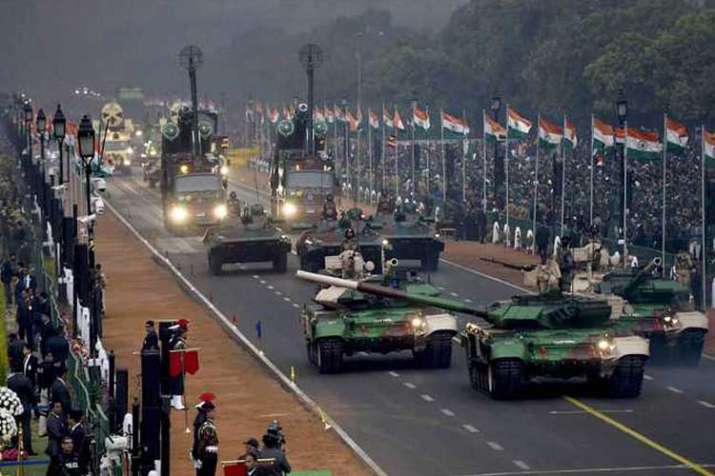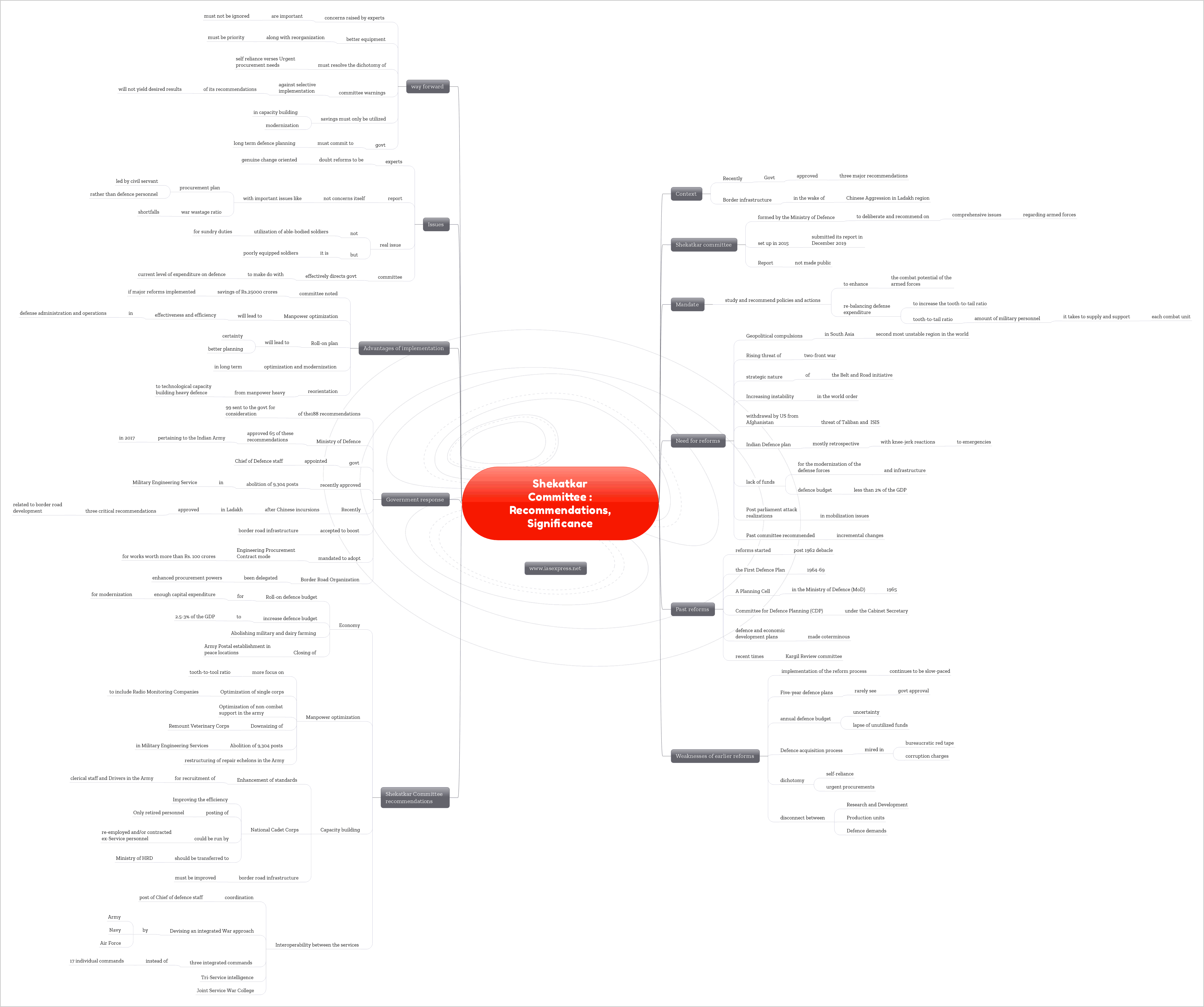Shekatkar Committee: Recommendations, Significance

From Current Affairs Notes for UPSC » Editorials & In-depths » This topic
IAS EXPRESS Vs UPSC Prelims 2024: 80+ questions reflected
The Shekatkar committee has been in news even during the Covid-19 pandemic as the exigencies along the border continue to haunt. The current government’s focus on national security and defense preparedness made it relook at the committee report in the wake of Ladakh border issues with China. It swung into action recently approving major recommendations of the committee.
What is the Shekatkar Committee?
- The Shekatkar committee was formed by the Ministry of Defence to deliberate and recommend on comprehensive issues such as the enhancement of armed forces capabilities, rebalance its expenditure, administrative, and logistic issues, etc.
- The committee was set up in 2015 and it submitted its report in December 2019.
- The report has not been made public yet as it relates to critical reforms in the defense sector and hence pertains to critical national security. Whatever information we get is from various news reports and interviews of related experts.
What is the need for reforms in the defence sector?
- The geopolitical compulsions make it imperative for our defense forces to be ever-ready for any contingencies. South Asia is the second-most unstable region in the world after West Asia and we must not be complacent based on our past military achievement.
- With a rising possibility of a two-front war on Western and North-Eastern front, the rising Chinese aggression, India faces a serious threat to its territorial sovereignty.
- The Strategic angle of the Belt and Road initiative has been a cause of concern for defense experts.
- Not only these traditional threats, increasing instability in the world order, US pulling out of Afghanistan, the threat of Taliban forces eying India are important concerns.
- Indian defense planning has been mostly retrospective rather than pro-active which are laced with knee-jerk reactions to emergency situations despite the imminent threats.
- There is a lack of funds for the modernization of the defense forces and infrastructure. For long the defense budget has been less than 2% of the GDP.
- The post parliament attack mobilization delays put forth very fundamental issues with respect to force deployment.
- Various committees in the past have had concerns about tri-services co-ordination.
- While there have been some committees that studied the situation of defense preparedness, their approach was mainly of incremental changes.
What are some early efforts towards defense reforms?
The Sino-Indian Conflict in 1962 and its result mandated a new defense consciousness in the country after years of neglect, and efforts in defense planning began in 1964.
After 1964, various efforts were taken to reform the defence sector. Some of these are
- Defense requirements were assessed on a five-year basis and the First Defence Plan (1964-69) was drawn up.
- A Planning Cell was established in 1965 in the Ministry of Defence (MoD).
- The Second Defence Plan (1969-74) was instituted on a ‘roll-on’ basis. After a year was completed, an additional year was tagged at the other end so that the armed forces would always have a revised and updated five-year plan. This method was found to be impractical.
- In 1960-70s The Committee for Defence Planning (CDP) was established under the Cabinet Secretary.
- In order to integrate defense planning with the overall economic planning effort, defence and economic development plans were made co-terminus.
- The only time a serious security review was undertaken in the recent past was after the Kargil Conflict of 1999 when the Kargil Review Committee (KRC) headed by the late K. Subrahmanyam was appointed
What have been the weaknesses of early reforms?
- While efforts have been made to improve defense planning, implementation of the reform process continues to be slow-paced.
- Five-year defence plans rarely see government approval. The 10th and the 11th Defence Plan were not approved at all and drifted along on an ad hoc basis.
- Annual defense budgets add an element of uncertainty to the planning process. The unutilized funds continue to lapse back at the end of the financial year.
- The defense acquisition of new weapons and equipment by the armed forces remains bound in bureaucratic red tape and controversies of corruption.
- There is a tussle of approaches between the aspiration of technological self-reliance in the political leadership and the desire of the services to import arms and equipment based on immediate operational exigencies.
- The disconnect between R&D, production agencies, and the defense demands remains unresolved. This delays the indigenous production process.
What was the mandate of the Shekatkar Committee?
It was expected to study and recommend policies and actions to enhance the combat potential of the armed forces and re-balancing defense expenditure with an aim to increase the tooth-to-tail ratio.
What is the tooth-to tail ratio?
It is the amount of military personnel it takes to supply and support each combat unit.
What are the recommendations given by the Shekatkar committee?
Based on the various news reports, some of the important recommendations are,
Economy
- Roll-on defence budget, so that enough capital expenditure can be made available for modernization instead of the current practice of surrendering unspent capital budget at the end of the financial year.
- Increase the defence budget to 2.5-3% of the GDP.
- Abolishing military and dairy farming.
- Closing of Army Postal establishment in peace locations.
Manpower optimization
- There should be more focus on the tooth-to-tail ratio that includes not only armed forces but also related organizations like the organizations that function under the MoD such as the DRDO, OFB, DGQA, defense estates, CGDA, BRO, the defense PSUs and not least of all, the MoD itself.
- Optimization of single corps to include Radio Monitoring Companies.
- Optimization of non-combat support in the army i.e. the supply corps, ordinance, and engineers. A performance audit of the role of non-combat organizations was also recommended.
- Downsizing of Remount Veterinary Corps which looks after horses and mules.
- Abolition of 9,304 posts in Military Engineering Services out of total of 13,157 vacancies in Basic and Industrial Stuff.
- Work of the MES could be partly done by the departmentally employed staff and other works could be outsourced.
- The reforms also include restructuring of repair echelons in the Army to include Base Workshops, Advance Base Workshops, and Static/Station Workshops in the field Army.
Capacity building
- Enhancement of standards for recruitment of clerical staff and Drivers in the Army.
- Improving the efficiency of the National Cadet Corps.
- Only retired personnel should be sent to the NCC
- NCC could be run by the re-employed and/or contracted ex-Service personnel.
- NCC should be transferred from the Defence Ministry to the Human Resource Development Ministry
- The border road infrastructure must be improved so as to make emergency mobilization seamless.
Interoperability between the services
- Appointment of the Chief of Defence Staff (CDS) for transforming single service organizations to integrated fighting units.
- Devising an integrated War approach by Indian Army, Navy, and Airforce.
- We should create three integrated commands instead of existing 17 separate commands
- The Tri-Service intelligence should be made.
- There Should be a Joint Service War College which will conduct the course of one year for mid-level officers from all the forces
What has been the government response to the recommendations?
- Of the 188 recommendations made by the Shekatkar Committee, 99 were sent to the armed forces for making an implementation plan.
- The Ministry of Defence approved 65 of these recommendations pertaining to the Indian Army, in August 2017.
- The reforms to be implemented include the re-deployment and restructuring of approximately 57,000 posts of officers, JCOs and Other Ranks and civilians, and most of the above-mentioned reforms
- The government accepted the long-awaited recommendation of appointing a Chief of Defence staff.
- The Defence Ministry recently approved the abolition of 9,304 posts in the Military Engineering Service.
- Based on the recent issues on the Ladakh border, the government swung into action. One of the first post-COVID-19 actions of the government is to accept three critical recommendations related to border infrastructure.
- The government has accepted to boost border road projects.
- For this, it has mandated to adopt Engineering Procurement Contract mode for execution of all works costing more than Rs. 100 crores.
- The Border Road Organization has been delegated enhanced procurement powers from RS. 7.5 crores to Rs. 100 crores.
What are the advantages of implementing the Shekatkar Committee recommendations?
- The committee has noted that if the majority of the recommendations are implemented in the next five years, the government can save up to Rs. 25000 crores from its current expenditure.
- Manpower optimization will lead to effectiveness and efficiency in defense administration and operations.
- The Roll-on plan will give the defense forces a free hand in planned utilization of the funds allocated to them.
- The implementation will result in the optimization and modernization of the defense forces in the long-term.
- The Defence force for long has been manpower-intensive when the world powers have moved for more sophistication and technology-based security reforms. This committee provides a way to the technological modernization of the defense forces.
What are the issues raised over the recommendations?
- Some experts believe that the recommendations do not suggest genuine reform measures and failed to comment on major lacunae.
- It has not concerned itself with the bottlenecks in defense procurement due to the structure of the Defence Procurement Board which is headed by the Defence secretary.
- It has not recommended anything on the shortfalls in the War Wastage Reserves.
- Experts feel that the real bane of the Indian Military is poorly equipped soldiers and not utilization of able-bodied men for sundry duties. The committee recommendation to withdraw 57000 men from so-called non-combat duties to save money is not forward-looking.
- The committee suggestions effectively tell the government that it must make do with the current level of expenditure by suggesting reorganization.
Way Forward
- Though the recommendations will have an important impact on defense administration, the concerns are also important.
- The Military’s needs for better equipment rather than reorganization must be discussed further.
- The defense procurement lies dormant due to the capability enhancement and self-reliance. The balance must be found as soon as possible.
- The committee warned that the selective implementation of the recommendations will not yield desired results.
- The savings must only be utilized in capacity building and modernization of the defence forces.
- The government must commit itself to long-term defense plans, otherwise, the defense modernization will continue to lag.
- The entire report, reportedly, is focussed on shedding the unnecessary cost and make India’s armed forces more agile and technology-oriented to meet current and future national security objectives.
- The government must seriously gauge the current and future threats and implement pertinent reforms to be ready for exigencies.
Conclusion
The government has been swift in action in the light of Chinese aggression in Ladakh but it again represents a reaction to the emergency situation and we do not see any proactive approach. We must be working very hard to bridge the power and preparedness gaps vis-à-vis or potential adversaries. The Shekatkar committee recommendations are part of the long drawn process of defense modernization and preparedness.
Practice Question for Mains
How the recent implementation of Shekatkar committee recommendations will help in improving India’s defense preparedness with respect to future threats. Elucidate (250 Words)
If you like this post, please share your feedback in the comments section below so that we will upload more posts like this.


